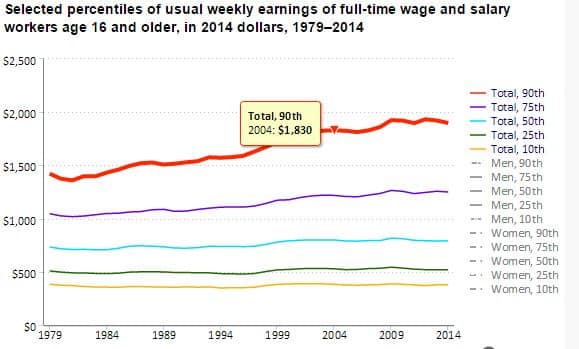Rich got richer: new evidence on wage earners

BUSINESS RECORD STAFF Jun 3, 2015 | 9:38 pm
1 min read time
325 wordsAll Latest News, Retail and Business
A new analysis of wages by the U.S. Census Bureau shows that the highest-paid workers gained an average of 33 percent over the past 35 years, while the lowest-paid workers showed basically no gain.
Overall, “real,” or inflation-adjusted, median weekly earnings increased by about 8 percent over that 35-year span.
During that period, real earnings for the highest-paid 10 percent of workers — those whose earnings were at or above the 90th percentile — increased from a minimum of $1,422 per week in 1979 to $1,898 per week in 2014. Earnings for the lowest-paid 10 percent of workers were basically unchanged over the period; those workers earned less than $383 per week in 1979 and less than $379 per week in 2014.
The Census Bureau, which tracked wages from 1979 to 2014, also found that wages for female workers, on average, increased 30 percent over that time while men’s wages change little. Women’s real median weekly earnings went up from $553 in 1979 to $719 in 2014, but still averaged lower than most workers. In fact, in every category of wage earner, women’s wages lagged behind men’s across that 35-year period.
However, in the highest-paid earners category, pay for women went up 67 percent, compared with 34 percent for men in that category.
Real weekly earnings have increased among the lowest-paid women, whereas they have decreased for men in that wage category, even though men still out-earn women.
A positive for Iowa workers is that the disparity in the wages between the top category of wage earners and the lowest wage earners was smaller here than in 80 percent of other states in the country. While top workers in several states earned five times what the category of the lowest-paid workers earned, in Iowa the disparity was a difference of four times the median weekly wage. South Dakota had the smallest disparity in wages with a 3.5 ratio.








